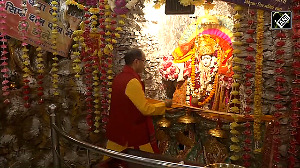Seven years ago, the Jatias, a Mumbai hotelier family, bought land in the city's derelict former textile mills district that was partly occupied by slums and was faced by a large shanty town - hardly where most would site a five-star hotel.
But this week, after years of navigating red tape, the 202-room Four Seasons Mumbai became the first luxury hotel of its size to launch in the city's south in about 20 years.
"In hindsight, the choice of this location seems quite straightforward but at that time this wasn't an obvious site for a hotel," Adarsh Jatia, a director of the family company, Magus Estates and Hotels, says.
Guests arriving at night at the Canadian chain's first hotel in India will see slum-dwellers sleeping on one side of the road and on the other the glittering glass tower of Mumbai's newest symbol of luxury.
In India 's financial capital, engine of the country's rapid economic growth, such scenes are increasingly common as high-end developments sprout up among the sprawling huts that house more than half the city's 18m people. With land prices in Mumbai reaching record levels, the state government of Maharashtra, which controls the city, has been pushing an ambitious plan to rehabilitate its legendary slums. The idea is to move slum-dwellers into apartment blocks occupying a corner of the area over which they sprawl and redevelop the remainder, in developments of hotels, offices and apartments.
The Four Seasons slum-dwellers living on the site were compensated for the loss of their homes and the government wants to use the model for two big slum rehabilitation projects that will transform the city if they are realised.
The first is Dharavi, said to be Asia's largest slum, and home to 60,000 families. The second is on the grounds of the city's airport where 80,000 families live. The two will involve moving between 5 per cent and 10 per cent of the city's population.
"This will be the way of the future," Mukesh Mehta, the consultant for the Dharavi project, says. "Especially in the prime part of the city of Mumbai and in Parel (the mill district) and all those areas that are the upcoming areas."
The result is not lost on those selling the new Four Seasons. "You're seeing Rolls-Royces on one side, luxury hotels on the other and slums in between - that's why they call Mumbai the Maximum City," Jason Stinson, marketing director at the hotel, says.
There are good business reasons behind the development. Property analysts estimate there is a shortage of 100,000 hotel rooms in India - more than the existing supply. Archaic restrictions that have prohibited the construction of high-rise buildings and sky-high land prices have contributed to the shortage, Vincent Lottefier, chief executive of Jones Lang LaSalle Meghraj, says.
Bureaucracy and a shortage of skilled workers make building hotels difficult - the opening of the Four Seasons was delayed by at least two years. The hotel needed 165 government permits - including a special licence for the vegetable weighing scale in the kitchen and one for each of the bathroom scales put in guest rooms. In the end, the hotel cost $100m (euro 64.5m, pound 51m), or about $500,000 per room, and prices - which start at $500 per night rising to more than $1,000 - reflect that.
But there is little social envy. Vishal Doshi, whose shop sells samosas in the slum, says the hotel brings prestige. "Everyone can now say: 'I'm living near the Four Seasons'," he says.
He is under no illusions that he will be a guest there any time soon. "This side of the road is for servants, that side for bosses," he says.







 © 2025
© 2025